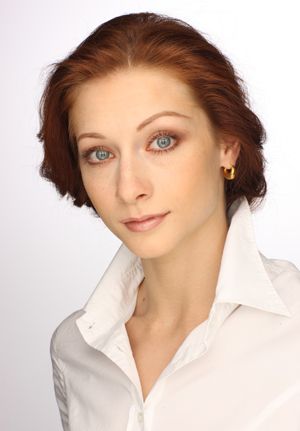
20 July 2025 | |
26 July 2025 | |
27 July 2025 |
Ekaterina Kondaurova is a dancer of strong character. Not delicate, lacelike or porcelain-like, but etched in stone.
Nezavisimaya gazeta
Tall, beautiful and with aristocratic facial features and a noble performing style, she has brilliantly danced the variations in La Bayadère, Paquita and Don Quixote. The particular chic of her performance, the art of instant improvisation, the ability to “give of herself” – a queen of the demimonde, perhaps, but still a queen! – have made Kondaurova the darling of the public.
Equally successful was her performance as the Angel of Death in Balanchine’s Serenade. A halo of mysticism accompanied her dance which was beautiful in every movement. Today she is, without a doubt, the most vivid individual among the Mariinsky Theatre’s young dancers.
Russian Bazaar
This ballerina was created for Balanchine’s ballets – technically complex and choreographically fanciful – here she opens up fully both as a technically supreme dancer and as a subtle dramatic actress.
PRO Dance
• Honoured Artist of Russia (2020)
• Recipient of the Benois de la Danse prize (2006)
• Recipient of the Golden Sofit, St Petersburg’s most prestigious theatre prize, in the category “Best Female Role in Ballet” in 2008 for the role of Alma in the ballet Glass Heart, in 2010 for the role of Anna Karenina in the ballet of the same name and in 2018 for the role in the ballet The Four Seasons
• Recipient of the Golden Mask, Russia’s most prestigious theatre prize, for “Best female role in ballet” (Anna Karenina in Anna Karenina ).
• Recipient of Ballet magazine’s Spirit of Dance award in the category “Star” (2011)
Born in Moscow.
Graduated from the Vaganova Academy of Russian Ballet in 2001.
Joined the Mariinsky Ballet in 2001. Principal since 2012.
Repertoire includes:
Giselle (Myrtha, Zulma); choreography by Jean Coralli, Jules Perrot and Marius Petipa,
Le Corsaire (Medora); production by Pyotr Gusev after the composition and choreography of Marius Petipa,
LaLa Fille du Pharaon (Aspicсia); choreography by Marius Petipa reconstructed by Toni Candeloro,
La Bayadère (Nikia, Gamzatti); choreography by Marius Petipa, revised version by Vladimir Ponomarev and Vakhtang Chabukiani,
The Sleeping Beauty (La Fée des Lilas); choreography by Marius Petipa, revival of the 1890 production, staging by Sergei Vikharev,
The Sleeping Beauty (Lilac Fairy); choreography by Marius Petipa, revised version by Konstantin Sergeyev,
Swan Lake (Odette-Odile); choreography by Marius Petipa and Lev Ivanov, revised version by Konstantin Sergeyev,
Raymonda (Raymonda, Henrietta, Grand pas); choreography by Marius Petipa, revised version by Konstantin Sergeyev,
“Paquita” Grand Pas (Variation); choreography by Marius Petipa,
Don Quixote (Queen of the Dryads, Street Dancer); choreography by Alexander Gorsky,
Michel Fokine’s ballets The Firebird (Firebird), Schéhérazade (Zobeide) and The Dying Swan,
George Balanchine’s ballets Prodigal Son (the Siren), Serenade, Symphony in C (Second Movement), The Four Temperaments (Choleric), Jewels (Emeralds, Rubies, Diamonds), La Valse and A Midsummer Night’s Dream (Titania, Hippolyta),
Marguerite and Armand (Marguerite); choreography by Frederick Ashton,
Le Jeune homme et la mort (the Girl); choreography by Roland Petit,
The Fountain of Bakhchisarai (Zarema, Maria); choreography by Rostislav Zakharov,
Spartacus (Phrygia, Aegina); choreography by Leonid Yakobson,
Pas de quatre (Marie Taglioni); choreography by Anton Dolin after motifs by Jules Perrot,
The Legend of Love (Mekhmeneh-Bahnu); choreography by Yuri Grigorovich,
Leningrad Symphony (the Girl); scenario and choreography by Igor Belsky,
Leonid Lavrovsky's ballets Romeo and Juliet (Juliet), Walpurgisnacht (Nymphs),
Carmen-Suite (Carmen); choreography by Alberto Alonso,
In the Night; choreography by Jerome Robbins,
5 Tango's; choreography by Hans van Manen,
Simple Things (Soloist); choreography by Emil Faski,
Benjamin Millepied's ballets Without and La nuit s’achève,
William Forsythe’s ballets Steptext, In the Middle, Somewhat Elevated and Approximate Sonata.
The Magic Nut (Temptress); production by Mihail Chemiakin, choreography by Donvena Pandoursky,
The Nutcracker (Queen of the Snowflakes, Oriental Dance); production by Mihail Chemiakin, choreography by Kirill Simonov,
Cinderella (Stepmother), The Little Humpbacked Horse (Mare, Sea Princess), Anna Karenina (Anna Karenina), Seven Sonatas and Concerto DSCH,
Ondine (Queen of the Sea); choreography by Pierre Lacotte,
Le Parc (Soloist); choreography by Angelin Preljocaj,
Gentle Memories; choreography by Jiří Bubeníček,
Sacre; choreography by Sasha Waltz,
Infra; choreography by Wayne McGregor,
The Bronze Horseman (the Queen of the Ball); choreography by Rostislav Zakharov, Yuri Smekalov,
Paquita (Paquita); choreography by Yuri Smekalov, reconstruction and staging of Marius Petipa's choreography (Act III Grand Pas) by Yuri Burlaka,
Anton Pimonov's ballets Choreographic Game 3x3, Inside the lines, The Cat on the Tree, Violin Concerto No 2,
The Four Seasons, Jeu de cartes (The Queen); choreography by Ilya Zhivoi,
The Fairy's Kiss (Fairy I); choreography by Maxim Petrov,
12 (Reader); choreography by Alexander Sergeev.
Repertoire also includes:
Reverence; choreography by David Dawson,
Le Bourgeois gentilhomme (the Marchioness Dorimène); choreography by Nikita Dmitrievsky,
Glass Heart (Alma); choreography by Kirill Simonov,
The Golden Age (Olga); choreography by Noah D. Gelber,
SeasonS, A Flashback; choreography by Ilya Zhivoi,
as part of the project The Dreamers: Within; choreography by Vladimir Varnava, Lose Yourself to Dance; choreography by Maxim Petrov and Ilya Zhivoi, Motherboard; choreography by Ilya Zhivoi.
She was the first performer of the roles of Alma in Kirill Simonov’s ballet Glass Heart (2008), the Mare in Rodion Shchedrin’s ballet The Little Humpbacked Horse, the Soloist in Emil Faski’s ballet Simple Things (2010) and Aegina in the full-scale 2010 revival of the ballet Spartacus (2010) with choreography by Leonid Yakobson (1956), and the key roles in Sasha Waltz’ Le Sacre du printemps and Concerto DSCH.